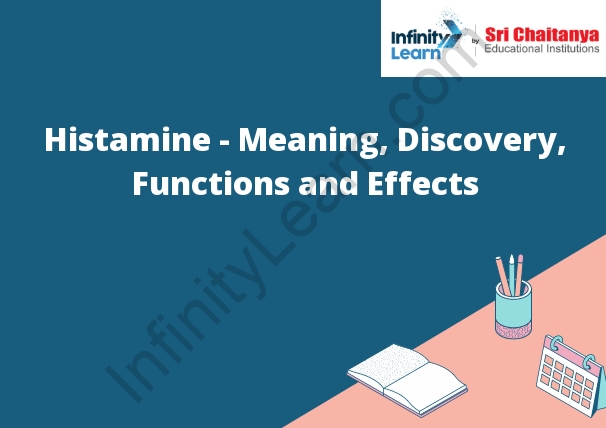Table of Contents
Histamine and Allergies
What do You Mean by Histamine and Its Functions?
Histamine – Meaning: Histamine is a chemical messenger that is released by cells in the body in response to injury or infection. Histamine plays a role in the body’s inflammatory response and is responsible for many of the symptoms of allergies, such as a runny nose, watery eyes, and sneezing. Histamine can also cause stomach cramps, diarrhea, and vomiting. Histamine is also involved in the regulation of heart rate and blood pressure.

What is Histamine?
Histamine is a neurotransmitter that mediates inflammation, itch, and sneeze responses. It is released from mast cells in response to allergens, injuries, and other stimuli. Histamine binds to histamine receptors on target cells, triggering the release of other inflammatory mediators. Histamine is also involved in the regulation of gastric acid production and the contraction of smooth muscle cells.
How Histamine was Discovered?
In 1901, German physiologist Paul Ehrlich was experimenting with a dye called methylene blue. He injected the dye into a group of white blood cells and watched as it was taken up by certain cells. He then injected the cells into a mouse and observed that the mouse developed a skin rash. Ehrlich concluded that the dye was being taken up by cells that trigger an immune response, such as mast cells.
In the early 1900s, it was discovered that histamine was responsible for the skin rash caused by the dye methylene blue. In the late 1920s, it was discovered that histamine was also responsible for the symptoms of an allergic reaction, such as a runny nose and itchy eyes.
Vasodilation
Vasodilatation is the widening of blood vessels. This can be caused by different mechanisms, including the release of a vasodilator substance, such as nitric oxide, from the endothelium of the vessel. When the endothelium is healthy, it produces nitric oxide in response to physical or mental stress. This substance then diffuses into the surrounding smooth muscle cells, causing them to relax and the vessel to dilate.
Nasal Mucosal Effect
The nasal mucosal effect is the way that drugs can be absorbed through the mucous membranes in the nose. This can be a very effective way to get drugs into the body, as they can be absorbed directly into the bloodstream. This can be a quicker way to get the drugs into the body than through other methods, such as oral ingestion.
Regulation of Sleep-Wake Cycle
Sleep is regulated by circadian rhythm, which is a 24-hour internal timekeeping system that is influenced by the environment. The circadian rhythm controls the sleep-wake cycle, which is the body’s natural process of alternating between periods of sleep and wakefulness. The sleep-wake cycle is regulated by the release of melatonin, which is a hormone that is released by the pineal gland in response to darkness. Melatonin signals the body to start preparing for sleep. The body’s circadian rhythm can be disrupted by factors such as light, noise, and stress, which can interfere with the body’s natural sleep-wake cycle.
Gastric Acid Production and Release
- The production of gastric acid is a complex process that involves the release of several hormones and the activation of special cells in the stomach lining.
- When food enters the stomach, the stomach lining cells release a hormone called gastrin. Gastrin causes the cells in the stomach lining to produce hydrochloric acid. Hydrochloric acid is the main component of gastric acid.
- The release of hydrochloric acid is controlled by another hormone called somatostatin. Somatostatin prevents the release of hydrochloric acid when the stomach is empty.
- When food is present in the stomach, somatostatin is inhibited and gastrin is released. This causes the cells in the stomach lining to produce hydrochloric acid.
- The hydrochloric acid produced by the stomach lining cells flows into the lumen of the stomach. The lumen is the space inside the stomach that food passes through.
- The hydrochloric acid in the lumen of the stomach helps to digest food. It also kills bacteria that may be present in the food.
Protection
- Protection is a form of insurance that provides a financial reimbursement in the event of a loss. Protection can be purchased in the form of property insurance, liability insurance, or health insurance.
- Property insurance protects the owner of property from financial losses due to damage or theft.
- Liability insurance protects the policyholder from financial losses due to legal claims made against them.
- Health insurance protects the policyholder from financial losses due to medical expenses.









